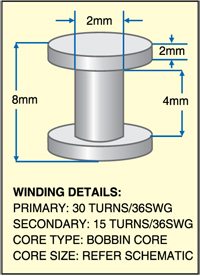 Ni-Cd batteries suffer from an undesirable memory effect due to partial discharge. The remedy is to completely discharge the battery before recharging.
Ni-Cd batteries suffer from an undesirable memory effect due to partial discharge. The remedy is to completely discharge the battery before recharging.
A simple resistor will do the discharging job nicely but there is the risk that the cell may discharge beyond a certain voltage and cause polarity reversal in the cell. Here is a simple circuit that discharges the cell to a level of 600 mV, ensuring that the cell is correctly discharged without the risk of polarity reversal. The battery is not discharged at a constant current. This allows the battery to recover during the intervals, to extend its useful life.

As shown in Fig. 1, the circuit is a simple flyback oscillator that oscillates at a frequency in kHz range depending on the winding of X1. Wind the primary with 30 turns of 36SWG wire and secondary with 15 turns round a bobbin core. Details of the bobbin size are shown in Fig. 2.

Working is simple. When the circuit is powered on, transistor T1 conducts and current flows through inductor X1. During the switched-off state, the energy stored in the inductor is discharged via LED1. Once the end-of-cell-discharge voltage is reached, the LED stops glowing, as voltage at the base goes below the forward conduction voltage (0.6V) of the transistor.
If you suspect a cell is suffering from the memory effect, discharge and recharge it a couple of times in succession. This will restore the capacity of the cell. For faster discharge, increase the load by connecting a few LEDs in parallel.









keep away nicd from memory effect